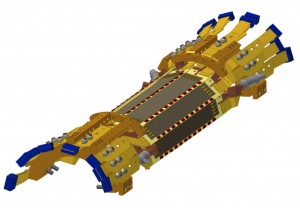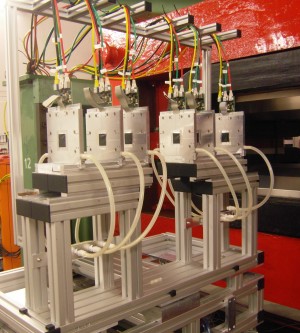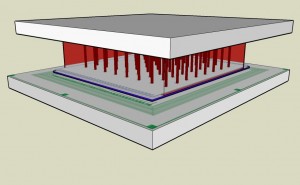
Isometric view of one half of the vertex detector for the BELLE-II experiment, based on the DEPFET technology. Image: DESY
Although the actual construction date of the ILC accelerator and its detectors is very uncertain, the impact of the R&D for ILC detectors is very real. We are so immersed in our day-to-day activities, in the analysis of physics and test beam data, in our struggles to obtain funding, that we tend to overlook the deep impact the work initiated by and carried out within the ILC detector community has already had on the whole particle physics community and beyond. Let’s take stock.

Beam telescope in the CERN and DESY test beam lines based on the MIMOSA-26 pixel sensors. Image: DESY
A key element to enable the ILC physics programme is the vertex detector. Primary and secondary vertex reconstruction of unprecedented accuracy is required to explore the heavy flavor and Higgs sectors. Extreme demands are put on the power consumption and mass budget of these detectors. Furthermore, detector occupancy and granularity, the readout speed and radiation hardness have to be commensurate with the experimental environment. R&D on multiple vertex detector technologies has been very active. The depleted field effect transistor (DEPFET) active pixel sensor has been studied extensively. This device is characterised by very low power consumption and the active area can be thinned to 50 micrometres (µm). Prototype detectors have been extensively beam-tested. Very good performance has been achieved to date. This development has not gone unnoticed by the BELLE-II collaboration at the KEK B-factory. Because of the extensive R&D carried out under the ILC umbrella, the BELLE-II detector had a mature technology available to be taken to the detector stage.
Another approach is the CMOS pixel sensor technology, which has the intrinsic advantages of the ability to implement very high granularity, very thin sensors and integrated processing circuitry in a commercial process. Driven by the ILC physics needs, more than 30 sensor prototypes have been produced in the MIMOSA series. A recent incarnation, the MIMOSA-26, is a matrix of 1152 x 576 pixels with a pitch of 18.4 µm. Beam telescopes in the test beam lines at both DESY and CERN, available to the whole user community, are currently equipped with this sensor. It is also the sensor of choice for the heavy flavor tracker of the STAR experiment at RHIC at Brookhaven in the US, expected to see data around 2013. An adapted version of this sensor also provides the baseline architecture for the micro-vertex detector for the Compressed Baryonic Matter experiment at FAIR at GSI in Germany. Also here, the long and extensive ILC R&D programme has brought this technology to a maturity level that it can be readily applied in these experiments.
Another type of sensor, the vertically integrated silicon, or 3-D technology for short, consists of layers of extremely thin silicon stacked on top of each other with interconnections between the layers. Each layer can be as thin as 7 µm and could be optimised for its function. This relatively new technology was unambiguously motivated by the requirements for ILC vertex detectors and is currently a serious candidate technology for the upgrades of trackers for the LHC experiments. The silicon-on-insulator (SOI) technology, another vertex detector technology actively being developed by the ILC community, has already been applied as an X-ray imager.

Conceptual view of a 3-D silicon assembly for a track trigger for an LHC upgrade showing a silicon sensor at the top and bottom interconnected through an interposer. Image: Ron Lipton
One of the hallmarks of an ILC detector is a fine-grained calorimeter enabling jet energy reconstruction through the particle flow concept. These calorimeters provide an image of the evolution of the interaction of the particles in the calorimeter that was not imaginable a decade ago. It is in large part made possible through the advent of silicon photo-diodes operated in Geiger mode, or SiPM, the ability to embed modern readout electronics inside the detector and for the associated data acquisition systems to handle large channel counts. The field of medical imaging has already recognised the potential of these calorimeters for proton computed tomography (pCT). pCT is very much like a fixed target experiment: a proton beam is measured before it hits a target, in this case part of the human body, and its direction and energy is measured when it exits the target. The new pCT detector concepts use miniature ILC calorimeters with SiPM readout as range detectors for the protons. This allows for cheaper experimental setups with faster readout providing more accurate images.

MicoMegas-based time projection chamber for the T2K experiment in Japan, based on ILC detector R&D. Image: T2K
An important element of the ILC physics programme is to uniquely map the Higgs sector. The most accurate determination of the Higgs mass is achieved through the recoil mass determination, which requires excellent charged particle momentum resolution. The time projection chamber (TPC) is the technology of choice for the ILD (International Large Detector) detector concept, the R&D for which is being carried out by the LC-TPC horizontal detector R&D collaboration. Different technologies are being studied in great detail in a large parameter space by the LC-TPC collaboration. In 2009 three large micro-pattern gas detector TPCs were installed in the near detector of the Tokai-to-Kamioka (T2K) experiment in Japan. The group readily states that without the ILC TPC R&D programme, there would have been no T2K TPCs. The T2K collaboration recently announced the observation of electron neutrino appearance events using the neutrino beam from J-PARC to the Super Kamiokande detector. This indication that muon neutrinos oscillate to electron neutrinos could imply that the last unknown neutrino mixing angle is relatively large. This is a nice example of the intricately interwoven matrix of detector development. The unconventional and unexpected marriage of a magnet used in the discovery of the W and Z bosons, combined with the groundbreaking R&D on a tracking detector for the proposed ILC project, has led to shedding light on a key parameter of the neutrino mixing matrix. Remarkable indeed!
Our record of forecasting science and technology research impacts is very poor. Sometimes, often in these economically challenging times, the impact of basic fundamental research is being questioned. The community, however, consistently demonstrates the widespread benefits resulting from inquiry-based research for the field of particle physics and beyond. Detector development for the ILC has penetrated already many areas of science as will be outlined in more detail in a forthcoming report. It is a testimony of the caliber of the work being carried out. The community can rightfully take pride in its already many accomplishments.


Recent Comments